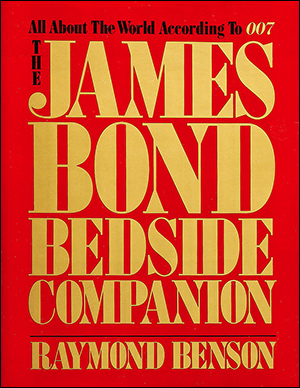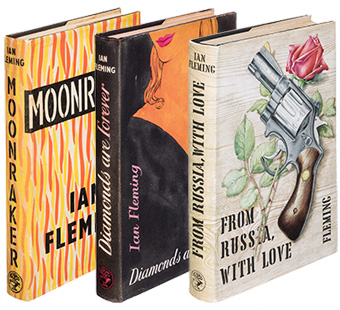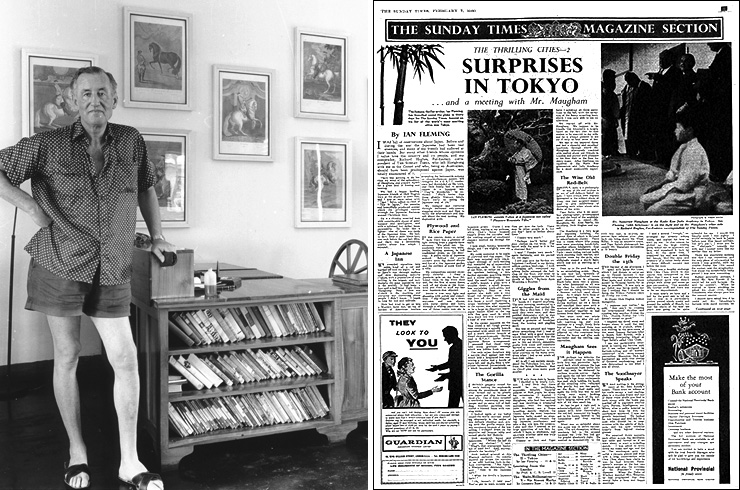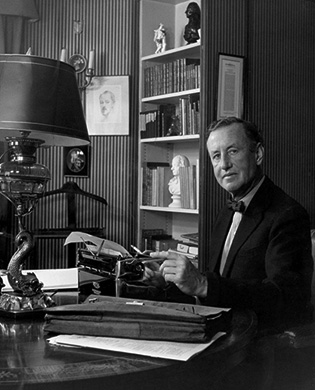|
From the Archive |
||||||
|
||||||
|
Originally published in 007 Issue #13 (1983) the text of this article is identical, but enhanced here with additional images from the 007 MAGAZINE Archive. |
||||||
 |
||||||
|
It seems like it’s in the middle of nowhere, but Bloomington, Indiana [home of the film Breaking Away (1979) directed by Peter Yates] is a wonderful little oasis at the junction of several two-lane country highways in the southern part of Indiana. It’s a small town, perhaps 80,000 people or so; its main claim to fame, of course, is Indiana University. Situated across from the Fine Arts building in a circular drive surrounding a fountain is the prestigious Lilly Library. Bloomington may seem like an out-of-the-way place to keep rare and valuable manuscripts, but the Lilly Library holds one of the most impressive collections of such items in the world. The Library first opened in June of 1960, and was named after the family which founded the Indianapolis pharmaceutical firm. J.K. Lilly, Jr. had donated a private library to begin the collection, and the books and manuscripts from the University Library’s Department of Special Collections were added as well. At this time, the collections numbered more than 75,000 books and 1,500,000 manuscripts. Today, the Library holds nearly 4,000,000 manuscripts, 350,000 printed books, and about 100,000 pieces of music. The Library serves two functions. The first capacity is that of a museum which mounts several exhibitions a year to coincide with special events at the University. The second function is that of a research library, which serves as a major source for writers and scholars from all over the world. One simply cannot comprehend the wealth of material that is stored in the building. |
||||||
 |
||||||
|
The collections are too broad and extensive to attempt to list here, but among the treasures located at Lilly is the New Testament portion of the Gutenberg Bible, printed in 1454, along with the Coverdale Bible. The latter is the first complete printing of the Bible in English. There are over 700 titles of incunables (books printed before 1501), as well as presses from the sixteenth century to the present. Religious works include many different Bibles and doctrinal manuscripts by Martin Luther and other Reformation figures. Works dealing with European expansion and Latin American history include the first and second Latin printings of the third Columbus letter announcing the discovery of America. British history is well represented with works leading to the Civil War (1642-49) and on up through the nineteenth century. U.S. history is strongly represented by over 5,000 printed books and 7,000 manuscripts dealing with the settlement of the continent (there are hand-printed accounts of overland excursions and a collection of gold rush newspapers). The Library’s collection of literature is the most extensive. First editions abound, and a few of the British authors represented are Chaucer, Spenser, and Shakespeare. There are manuscripts by authors such as J.M. Barrie, Arnold Bennett, Joseph Conrad, D.H. Lawrence, W. Somerset Maugham, Harold Pinter, and many others. Americans are represented by Cooper, Hawthorne, Emerson, Poe, Twain, Sinclair, etc. etc., The music collection includes the earliest known manuscript of Robert Burns’ “Auld Lang Syne”. |
||||||
|
||||||
|
The CASINO ROYALE typescript is heavily corrected and is 238 pages long. There are no inserts in this one because the first James Bond novel was written entirely from Fleming’s own imagination and experience. The corrections were mainly for spelling (he had crossed out “Biretta” and substituted “Beretta”) and grammar. |
||||||
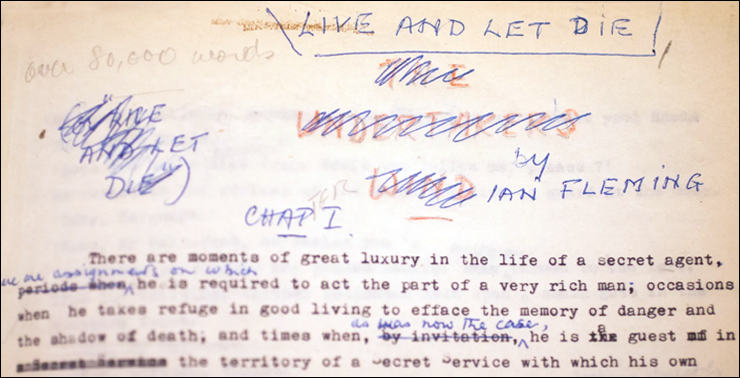 |
||||||
|
LIVE AND LET DIE holds the most corrections and inserts. The title of the book was originally “The Undertaker's Wind”, and there are a couple of inserts on stationery from the RMS Queen Elizabeth. Some interesting changes made in the novel include the substitution of Haiti for Martinique, and a deleted final paragraph. Originally, after Solitaire says, “What about my back?”, Bond reaches down the front of Solitaire’s pyjamas and says that her back must “get well quickly.” He then adds, “You never know when you may need it!” Also, interesting to note is that Fleming originally killed Felix Leiter. Readers will recall that Leiter “disagreed with something that ate him” and was dumped in a Florida hotel room in a pile of bloody rags. In the original typescript, Leiter is dead as a doornail, and is missing both arms, an entire leg, most of his torso, and half of his face. Naomi Burton, Fleming’s first American agent, told me she had protested the killing of this fine character when she first read the manuscript. Apparently, Fleming decided to change it, and converted Leiter’s fate to losing only one arm, half of a leg, and receiving minor face lacerations. |
||||||
|
||||||
|
FROM RUSSIA, WITH LOVE is heavily corrected, and it is obvious that Fleming took great care with this novel. It’s interesting to note a few of the changes made. At the end of Chapter Nine, Tatiana Romanova does not run from Rosa Klebb’s apartment in a panic after Klebb dresses in a negligee. Instead Klebb sits on the sofa and gestures for Tania to sit beside her. Klebb says, “We must get to know each other better,” and the chapter ends. This leads one to imagine the unthinkable. The ending of the book is different as well, for Bond is not kicked by Klebb with the poison-tipped shoe. Instead, Bond successfully pins Klebb on the floor with a chair during their struggle. Mathis and his men enter the room and take the woman away. DOCTOR NO contains mainly spelling and grammar corrections. The first chapter had originally been titled “The Quick, Neat Job”, but was changed to “Hear You Loud And Clear”. Fleming never titled his chapters as he wrote the book, but rather would go back later and do so. |
||||||
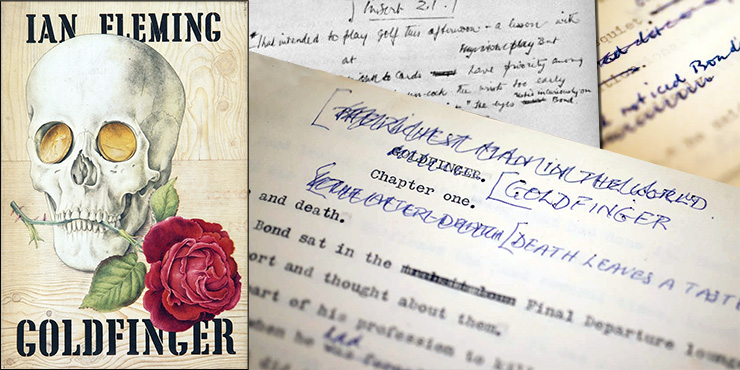 |
||||||
|
GOLDFINGER is the longest of the novels, numbering 270 pages in total. It is moderately corrected, and the working title was ‘The Richest Man In The World’. Fleming’s first short story collection was originally going to be called “The Rough With The Smooth”, but was later titled FOR YOUR EYES ONLY. The typescripts for the stories are all moderately corrected. FOR YOUR EYES ONLY was first entitled “Man’s Works”, then was later changed to “Death Leaves An Echo”. RISICO had an original spelling of “Risiko”. |
||||||
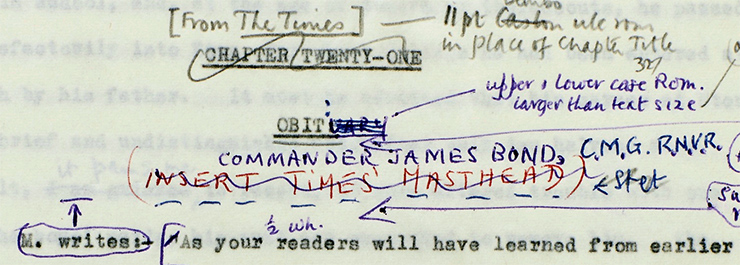 |
||||||
|
THUNDERBALL is not included in the collection at Lilly. Perhaps it is because of the court case which resulted from the publication of the novel. THE SPY WHO LOVED ME is randomly corrected, and is the shortest Bond novel at 113 pages. The original title to Chapter One was “Dusk That Evening”, rather than “Scaredy Cat”. ON HER MAJESTY’S SECRET SERVICE was originally called “The Belles of Hell”, and contains several inserted sections that were added after Fleming had returned to England from ‘Goldeneye’. These sections include the chapters on heraldry and biological warfare. YOU ONLY LIVE TWICE is the least corrected of the novels; no significant changes were made from the original manuscript, save for the odd spelling. The Lilly Library was also unable to obtain THE MAN WITH THE GOLDEN GUN, since the manuscript was revised and published after Fleming’s death in 1964. But the Library holds Fleming’s own collections of his novels, which he had bound in full morocco of varying colours. They are not uniformly first editions, but the Library does have an additional collection of the first editions. They are all featured in their attractive dust jackets, and many of the author’s own copies contain a hand-written note on the inside cover. These notes basically relate a few facts about his writing of the novel, and if a particular character is based on a living person. The Library also holds a copy of the autographed and numbered limited edition of ON HER MAJESTY’S SECRET SERVICE which contains the frontispiece of Fleming by Amherst Villiers. |
||||||
|
||||||
|
In addition to the Bond pieces, the Library also holds the original manuscript of Thrilling Cities, the series of Sunday Times “travelogues” which Fleming wrote in the fall of 1959. But of particular interest is the fact that the Library possesses the only bound copy of Fleming’s unpublished book, State of Excitement - Impressions of Kuwait. Fleming had been invited by the Kuwait Oil Company in the fall of 1960 to write a book about the country’s way of life and how the oil industry had affected it. It was a condition of the deal that the book should have the approval of the Oil Company before publication. Fleming wrote the book with zest, because the adventurous past of the country fascinated him. When State of Excitement was finished, the Kuwait Oil Company approved the book but felt it was their duty to show the manuscript to the Kuwait Government. The Sheikhs concerned didn’t particularly take to Fleming’s certain mild comments and criticisms referring to the country’s history of pirating and bloodshed. They wanted to project a more “civilized” image to the world, and the book was banned from publication. As a result, the only bound copy belonged to Fleming. The typescript is 145 pages long, interspersed with several black and white photographs of the country. |
||||||
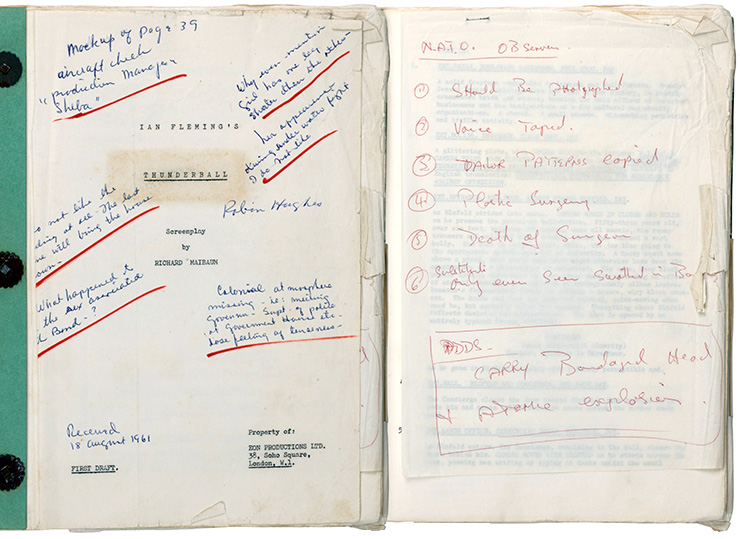 |
||||||
|
Other Bond-related items in the Library are the first five film scripts, including an original Thunderball screenplay by Richard Maibaum. This was written in 1961 when EON Productions first acquired the rights to the novels and their first production was being planned. But because THUNDERBALL was in litigation at the time, Dr. No was substituted after Maibaum had written this screenplay. Another item of value to me in my research for my own book was a collection of most of John Pearson’s research for his biography, The Life of Ian Fleming. These manuscripts were sold to the Library by Leonard Russell, editor of The Sunday Times. The file contains xeroxes and many originals of letters to and from Fleming; correspondence between Pearson and important people in Fleming’s life (such as William Plomer, Ernan Forbes-Denis, John Godfrey, Sir William Stephenson, etc.), most of which went into Pearson’s book; and many photographs, some of which were not included in the book. |
||||||
|
||||||
|
I was only able to spend two days at the Library, and was barely able to cover what I needed to see. One could easily spend weeks simply weeding through the Ian Fleming manuscripts. For the serious-minded who wish to study this material, I strongly recommend they do so. It is well worth the trip. You must write to the Curator of Manuscripts, Ms. Saundra Taylor, and inform her of your plans. Unless you have a legitimate research project as reason for the visit, you may have some trouble obtaining permission to see everything, but perhaps not. As I left the lush, green area of Bloomington after my research had been completed, I discarded my previous notions that it seemed very strange that Ian Fleming’s works were stored at such a place. Now I am confident that the manuscripts and books will be perfectly safe at the Lilly Library, and they will be used in a way Fleming himself would have wanted. |
||||||
|
|
||||||

